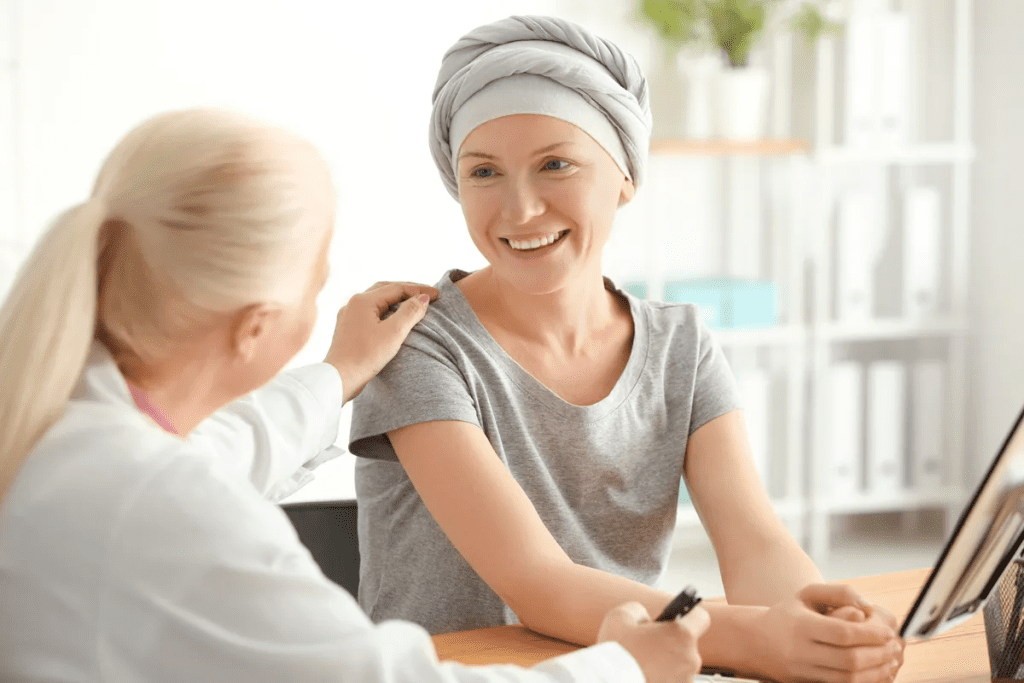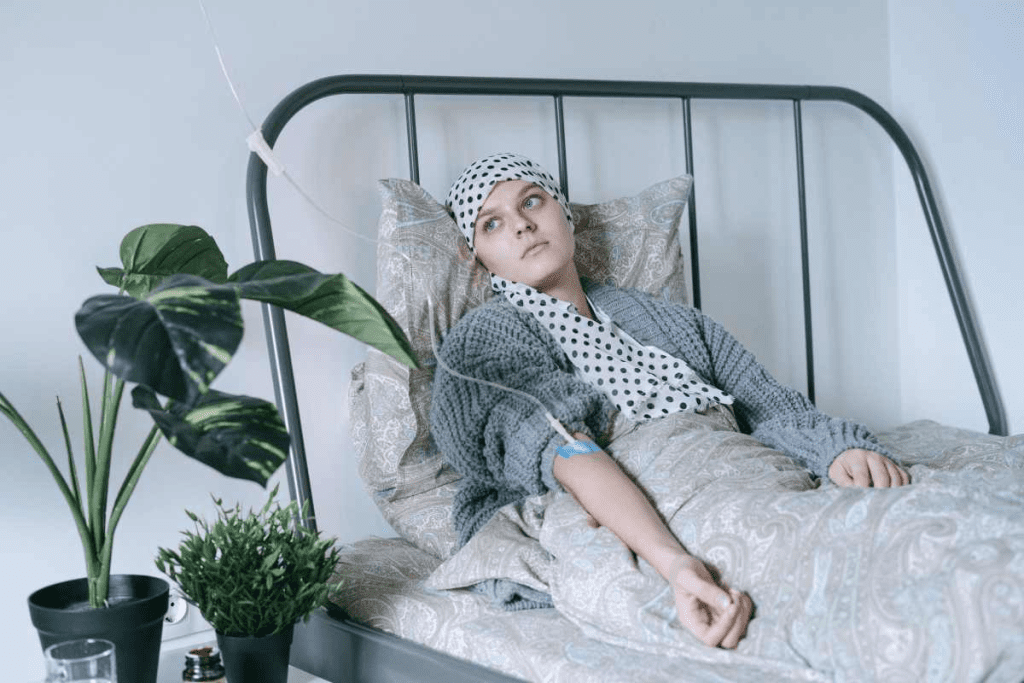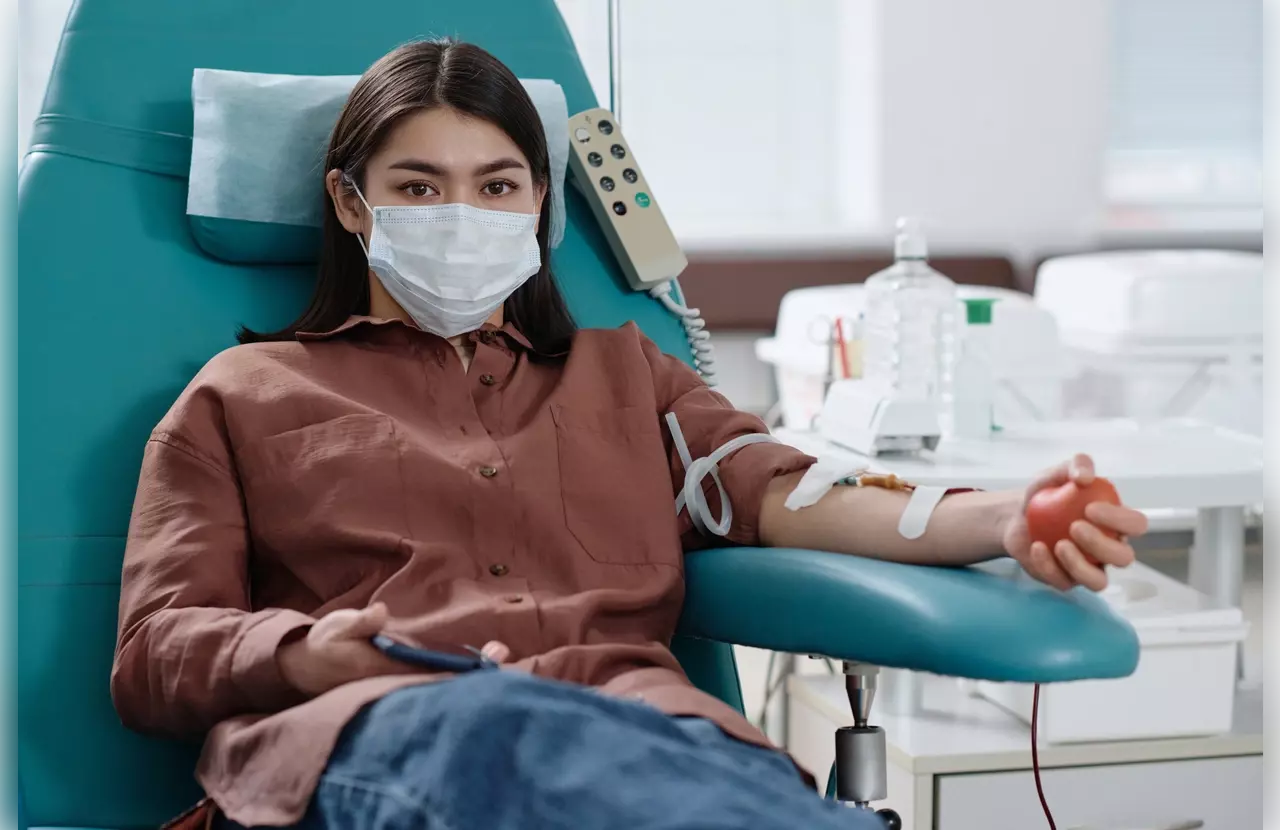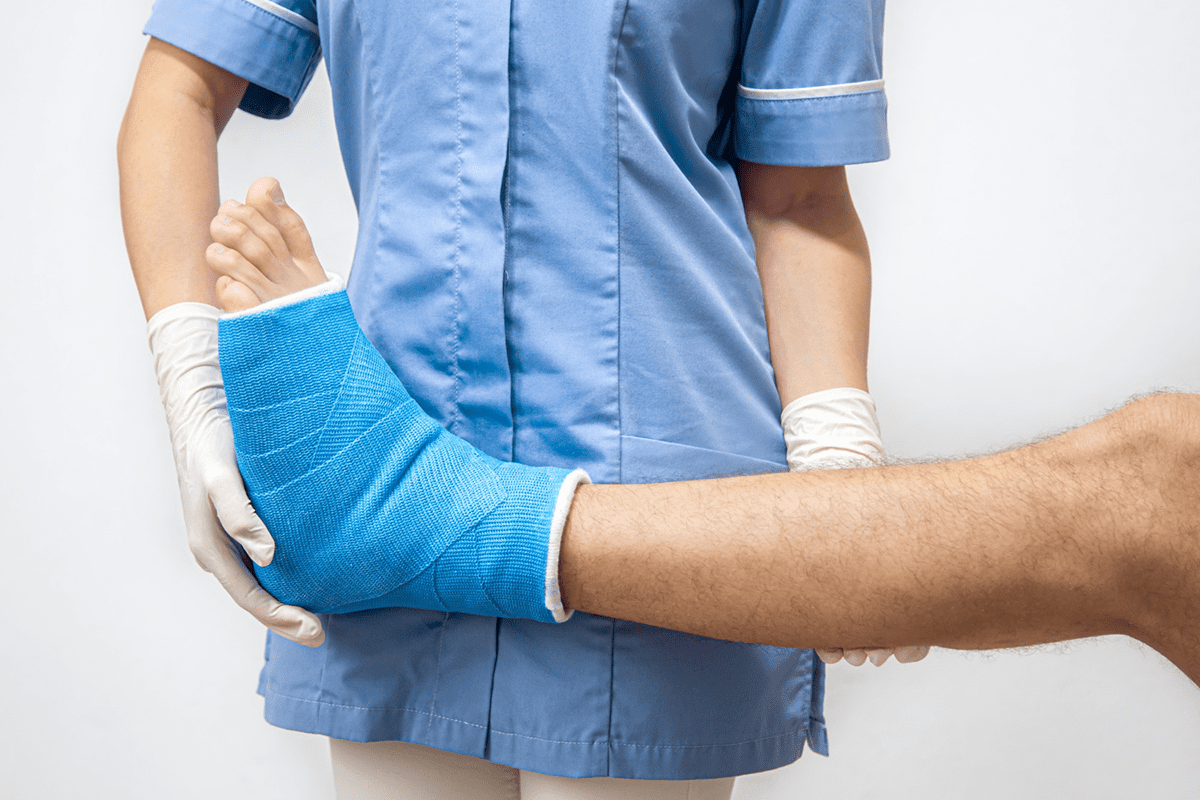Last Updated on November 26, 2025 by Bilal Hasdemir

Cancer treatment is tough for patients and their loved ones. When a family member gets chemotherapy, you might want to comfort them. But, it’s key to know the dangers of touching them after treatment.Chemotherapy precautions for family members at home stress careful contact, hygiene, and avoiding exposure to toxins.
Did you know chemotherapy drugs stay in body fluids like urine and vomit for days? This can be risky for family members who touch these fluids. The American Cancer Society says some drugs can harm others through bodily fluids.
To stay safe, follow chemotherapy precautions. Simple steps like wearing gloves and washing hands help a lot. Also, keep your distance to avoid contact.
Key Takeaways
- Understand the risks associated with chemotherapy exposure.
- Follow safety guidelines to minimize risks to family members.
- Take simple precautions, such as wearing gloves and washing hands.
- Avoid close contact with patients after chemotherapy treatment.
- Be aware of the possible dangers of chemotherapy drugs in bodily fluids.
Understanding Chemotherapy and Its Effects

To understand the precautions for those around chemotherapy patients, we need to know what chemotherapy is and how it works. Chemotherapy is a treatment that uses strong drugs to kill cancer cells all over the body.
What Is Chemotherapy?
Chemotherapy, or “chemo,” is a cancer treatment that uses drugs to fight cancer. It treats different cancers, alone or with other treatments like surgery or radiation.
The main goal of chemotherapy is to stop or slow cancer cells from growing. These cells grow fast and can spread. Chemotherapy drugs target these cells, either by killing them or stopping them from making more.
How Chemotherapy Drugs Work in the Body
Chemotherapy drugs target cells that grow fast, like most cancer cells. They can be given through IV, pills, or injections. Once in the body, they travel through the blood to reach cancer cells everywhere.
Chemotherapy drugs work in different ways. Some damage the DNA of cancer cells so they can’t reproduce. Others stop cancer cells from dividing.
Common Types of Chemotherapy Treatments
There are many types of chemotherapy, each with its own set of drugs. The choice depends on the cancer type, stage, and the patient’s health. Some common types include:
- Adjuvant chemotherapy: Given after primary treatment to reduce cancer recurrence risk.
- Neoadjuvant chemotherapy: Given before main treatment to shrink tumors.
- Palliative chemotherapy: Focuses on easing symptoms and improving life quality in advanced cancer.
Knowing about chemotherapy helps family and caregivers support patients safely. It helps avoid risks from exposure to chemotherapy drugs.
The Science Behind Chemotherapy Exposure Concerns

Chemotherapy drugs can be passed on to others in different ways. This worries family and caregivers about the safety of those getting treatment.
How Chemotherapy Drugs Can Transfer Between People
Chemotherapy drugs are made to kill fast-growing cancer cells. But, they can also spread to others through body fluids, contaminated surfaces, or bad handling of waste. It’s important to know that these drugs can stay in a patient’s body for a while after treatment, putting others at risk.
Chemotherapy drugs can move from one person to another through:
- Direct contact with body fluids like urine, feces, saliva, or vomit
- Touching surfaces that have chemotherapy drugs on them
- Handling clothes or bedding that have touched chemotherapy drugs
Routes of Possible Exposure
Knowing how chemotherapy drugs can spread is key to reducing risks. Exposure can happen through skin contact, breathing in drug particles, or eating contaminated things. Family and caregivers need to be aware of these risks to protect themselves.
Some common ways people can get exposed include:
- Touching the patient’s skin, if there’s chemotherapy residue on it
- Breathing in chemotherapy drug particles during treatment or when touching contaminated things
- Eating or drinking things that have touched contaminated surfaces or hands
By knowing these risks and taking steps to avoid them, caregivers and family can keep themselves safe. They can also give the best care to their loved ones who are getting treatment.
Can You Actually Touch Someone on Chemotherapy?
Many people wonder if it’s okay to touch someone who’s getting chemotherapy. Chemotherapy drugs are strong, and touching them might be a worry.
Debunking Common Myths
Some think chemotherapy patients are “radioactive” or that touching them is risky. But, the truth is more complex. Chemotherapy drugs can be in urine, feces, and vomit. Yet, the chance of getting sick from touching them is usually small.
It’s key to know the difference in types of contact. Holding hands or hugging is usually safe a few days after treatment starts. But, touching more closely or handling bodily fluids needs extra care.
When Physical Contact Is Safe
Touching someone getting chemotherapy can be comforting. Usually, after a few days of treatment, it’s okay to touch casually.
- Giving gentle hugs or holding hands is usually okay after the first few days of treatment.
- Being near the patient or sharing a meal together is considered safe.
When Caution Is Necessary
Even though casual touch is often safe, some situations need more care. When dealing with bodily fluids, like cleaning up after the patient, you should take precautions.
| Situation | Precaution |
| Handling bodily fluids | Wear gloves, wash hands thoroughly |
| Intimate contact | Avoid during and shortly after treatment |
| Sharing bathroom facilities | Clean surfaces regularly, avoid direct contact with bodily fluids |
Knowing when it’s safe to touch someone on chemotherapy and when to be careful helps. Family and caregivers can offer the right support while keeping risks low.
Symptoms of Second-Hand Chemotherapy Exposure
Chemotherapy is a common cancer treatment. Knowing about second-hand exposure is key. If someone in your home is getting chemo, knowing the symptoms is important.
Immediate Reactions to Be Aware Of
Reactions to second-hand chemo can vary. They depend on the drugs and how much you’re exposed to. Here are some common symptoms:
- Nausea and Vomiting: Some people get sick or vomit after exposure.
- Fatigue: Feeling very tired or weak could mean you’ve been exposed.
- Skin Irritation: Skin rashes or irritation can happen from touching contaminated surfaces or fluids.
Long-Term Exposure Concerns
Long-term exposure to chemo drugs is also risky. It can lead to serious health problems, including:
- Increased Risk of Cancer: Long-term exposure to some chemo agents may raise the risk of getting another cancer.
- Reproductive Issues: Chemo drugs can cause fertility problems and birth defects.
- Immune System Suppression: Long-term exposure can weaken your immune system, making you more likely to get sick.
| Exposure Duration | Potential Health Risks |
| Short-term | Nausea, Vomiting, Fatigue, Skin Irritation |
| Long-term | Increased Cancer Risk, Reproductive Issues, Immune System Suppression |
Who Is Most Vulnerable to Secondary Exposure
Some people are more at risk from second-hand chemo exposure. This includes:
- Children: Kids are more vulnerable because their immune systems are not fully developed and their bodies are smaller.
- Elderly Individuals: Older adults have weaker immune systems, making them more susceptible to chemo’s effects.
- Pregnant Women: Chemo drugs can harm the developing fetus, leading to birth defects and developmental problems.
Knowing who is most at risk helps families protect them. By understanding the symptoms and risks, we can create a safer environment for everyone.
How Long Does Chemotherapy Stay in a Patient’s System?
It’s important for caregivers and family members to know how long chemotherapy stays in a patient’s system. This knowledge helps them take steps to avoid exposure to chemotherapy drugs in bodily fluids.
Typical Clearance Timeframes for Different Chemo Drugs
Chemotherapy drugs clear from the body at different rates. Some are gone quickly, while others take longer.
| Chemotherapy Drug | Typical Clearance Timeframe |
| Doxorubicin | Up to 7 days |
| Cyclophosphamide | 2-3 days |
| 5-Fluorouracil | Less than 1 day |
Table: Typical clearance timeframes for common chemotherapy drugs.
Factors Affecting How Long Chemo Remains in the Body
Several factors can affect how long chemotherapy drugs stay in a patient’s system. These include the patient’s metabolic rate, kidney and liver function, and the specific chemotherapy regimen used.
- Metabolic rate: Patients with a faster metabolism may clear chemotherapy drugs more quickly.
- Kidney and liver function: These organs play a key role in filtering and eliminating chemotherapy drugs from the body.
- Chemotherapy regimen: Different chemotherapy drugs have varying clearance times.
The 7-Day Rule in Chemotherapy Safety
The 7-day rule is a general guideline for chemotherapy safety. It suggests that many chemotherapy drugs are significantly cleared from the body within 7 days after treatment. But, this rule is not absolute, as clearance times can vary based on several factors.
Caregivers and family members should talk to healthcare providers to understand the specific precautions needed for the patient they are caring for.
Chemotherapy Precautions for Family Members at Home
It’s important to know how to keep everyone safe when someone is getting chemotherapy at home. Safety isn’t just for the person getting treatment. It’s also for the family and those helping out.
General Safety Guidelines
Family members need to take some basic steps to stay safe. Wearing gloves when touching the patient’s fluids is a good idea. This includes urine, feces, or vomit, which might have chemotherapy drugs in them. Also, clean and then disinfect any surfaces that might have come into contact with these fluids.
Knowing the patient’s treatment schedule is key. Staying away from the patient during treatment can also help.
Handling the Patient’s Laundry and Linens
Laundry and linens from a chemotherapy patient need special care. Washing them separately from other laundry is best. Wearing gloves when handling these items helps prevent skin contact.
Hot water and a mild detergent in the washing machine can help. Adding an extra rinse cycle can remove any leftover chemotherapy drugs.
Bathroom Sharing Considerations
Sharing a bathroom can be tricky when someone is getting chemotherapy. It’s best if the patient has their own bathroom to avoid exposure to drugs in bodily fluids. If that’s not possible, cleaning the bathroom well after the patient is very important.
Good ventilation in the bathroom is also important. Family members should be careful when using the bathroom after the patient. This is because fluids from vomiting or diarrhea can have a lot of chemotherapy drugs.
Oral Chemotherapy: Special Considerations
Oral chemotherapy is convenient but needs careful handling to avoid risks. It’s important to know how to handle it safely as it becomes more common.
Why Can’t You Touch Chemo Pills?
Chemotherapy pills are strong drugs that kill cancer cells. But, they can be dangerous if not handled right. Even a little bit of chemotherapy can be harmful if it gets into your body.
Handling chemo pills can lead to risks. Here are some:
- Direct skin contact can lead to absorption of the drug.
- Transferring the drug to other surfaces or people through touch.
- Inhalation of powder from crushed or broken pills.
Safe Handling of Oral Chemotherapy
Handling oral chemotherapy safely involves using the right techniques and precautions. Here are some tips:
- Use gloves: Wear disposable gloves when handling chemotherapy pills or capsules to prevent skin contact.
- Cut pills safely: Use a pill cutter to avoid crushing pills. If a pill must be crushed, do it in a sealed container or bag to prevent powder from becoming airborne.
- Dispose of waste properly: Dispose of any materials that have come into contact with chemotherapy drugs, including gloves, pill containers, and any cleaning materials, in a sealed bag or container.
Oral Chemotherapy Side Effects and Exposure Risks
Oral chemotherapy can cause side effects like nausea, fatigue, and hair loss. But, there’s also a risk of exposure to others. Body fluids, including urine, feces, and vomit, can contain chemotherapy drugs and pose a risk to others if not handled properly.
To reduce these risks, patients and caregivers should follow these guidelines:
| Precaution | Description |
| Hand Hygiene | Wash hands thoroughly after handling chemotherapy drugs or coming into contact with patient body fluids. |
| Laundry | Wash clothing and linens that have come into contact with chemotherapy drugs or body fluids separately from other laundry. |
| Bathroom Cleaning | Clean the bathroom regularly, paying particular attention to the toilet area, to prevent the spread of chemotherapy drugs. |
By understanding the risks of oral chemotherapy and following safe handling practices, we can minimize exposure risks. This ensures a safer treatment environment for everyone.
Special Considerations for Intimate Partners
When a loved one is going through chemotherapy, partners face a lot of precautions. They need to make sure they stay safe and help the patient too.
Sexual Contact Precautions
Chemotherapy drugs can be in fluids like semen and vaginal secretions. This can be risky for partners. To stay safe, barrier methods like condoms and dental dams are key. It’s also wise to avoid sex during treatment and for a bit after, as doctors suggest.
Following the oncologist’s advice on sex during chemo is very important. Some drugs need more caution than others.
How Long After Chemo Is Intimate Contact Safe?
The wait time for safe sex after chemo depends on the drugs and the patient. Doctors usually say wait 48 to 72 hours before sex. But, some drugs might need longer.
| Chemotherapy Drug Type | Recommended Waiting Period |
| Alkylating Agents | 72 hours to 1 week |
| Antimicrotubule Agents | 48 to 72 hours |
| Topoisomerase Inhibitors | 48 to 72 hours |
How Long After Chemo Is Sperm Safe?
Men on chemo worry about sperm safety. Drugs can harm sperm, risking genetic issues in kids. Doctors say wait 6 months to a year before trying to conceive, based on the treatment.
Some men are told to bank sperm before chemo. This way, they can have kids later without worrying about drug effects.
Protecting Vulnerable Household Members
Keeping children and pets safe from chemotherapy is very important for families with cancer. When someone in the family is getting chemo, everyone needs to be careful. This helps keep everyone safe.
Precautions for Children in the Home
Children are more at risk because their immune systems are not fully grown. They might touch things they shouldn’t or accidentally eat something harmful. To keep them safe, it’s important to keep the house clean and wash hands often.
Key precautions include:
- Limiting close contact between children and the chemotherapy patient, specially during and right after treatment.
- Using protective gear like gloves when handling the patient’s laundry or cleaning up after them.
- Telling children about the importance of washing their hands often.
Is It Safe for Chemo Patients to Hold Babies?
Whether a chemo patient can hold a baby depends on a few things. These include the type of chemo, when it’s given, and the patient’s health. Usually, it’s best to avoid holding babies during the first parts of treatment or right after.
“It’s very important for patients and their families to know the risks of chemo exposure. They should take steps to reduce these risks,” says a leading oncologist.
Pet Safety Around Chemotherapy Patients
Pets can get exposed to chemo if they touch their owners or come into contact with their bodily fluids. It’s important to take steps to prevent this. This includes washing hands before touching pets and not sharing food or utensils.
Pet owners should be aware of the following:
- Avoiding close contact between pets and the chemotherapy patient, specially if the patient has vomited or had diarrhea.
- Keeping the patient’s laundry and bedding separate from pets’ areas.
- Regularly cleaning food and water bowls, as well as any surfaces pets come into contact with.
Proper Personal Protective Equipment (PPE) for Caregivers
When caring for someone with chemotherapy, it’s key to know about personal protective equipment. Chemotherapy drugs can harm not just the patient but also caregivers. Using the right PPE is vital to avoid exposure to these strong medicines.
When to Use Chemotherapy Gloves
Chemotherapy gloves are a must for caregivers. Wear them when touching bodily fluids, laundry, or anything that might have touched chemotherapy drugs. It’s important to pick gloves made for handling chemotherapy, as they offer better protection.
Key situations for using chemotherapy gloves include:
- Handling patient laundry or linens
- Cleaning up spills or bodily fluids
- Administering oral chemotherapy
- Disposing of waste that may be contaminated with chemotherapy drugs
Additional Protective Gear
Other protective gear might be needed too, like gowns, masks, and eye protection. For example, a gown and mask are good if there’s a chance of splashing or spraying. This adds extra safety.
The level of protection needed can vary based on the type of chemotherapy and the patient’s condition.
| PPE Component | Usage Scenario |
| Chemotherapy Gloves | Handling bodily fluids, laundry, or contaminated materials |
| Gowns | Risk of splashing or spraying bodily fluids |
| Masks | Risk of airborne pathogens or chemotherapy drug particles |
| Eye Protection | Risk of splashing bodily fluids into the eyes |
Proper Disposal of Contaminated Materials
It’s important to dispose of materials with chemotherapy drugs properly. This prevents harm to the environment and others. Caregivers should follow guidelines for hazardous waste disposal, using special containers for chemotherapy waste.
By following these steps and using the right PPE, caregivers can lower risks when caring for chemotherapy patients. Knowing the patient’s chemotherapy plan is also key, as it affects the needed precautions.
Home Environment Considerations During Chemotherapy
The home environment is key for those going through chemotherapy. Chemotherapy drugs can be in bodily fluids and waste. It’s important to protect family members and caregivers from exposure.
Chemotherapy and Septic Systems
Chemotherapy can affect septic systems in the home. Drugs can get into the system through urine and feces. This can upset the balance of bacteria needed for the system to work right.
Considerations for Septic Systems:
- Tell your septic system professional about your treatment.
- Don’t flush chemotherapy drugs or contaminated items down the toilet.
- Follow local rules for getting rid of hazardous waste.
Safe Cleaning Practices
Cleaning at home must change to stop the spread of chemotherapy drugs. Use disposable cloths or paper towels on surfaces that might have come into contact with bodily fluids. Then, throw them away properly.
| Surface | Cleaning Method | Disposal |
| Bathroom surfaces | Use disposable wipes with a bleach solution | Dispose in a sealed bag with other hazardous waste |
| Bed linens | Wash separately in hot water with detergent | Can be washed with other laundry after a cycle with detergent |
| Toilet area | Clean with a toilet brush and disposable wipes | Dispose of wipes in a sealed bag |
Managing Chemotherapy Waste at Home
It’s important to handle waste from chemotherapy carefully. This includes getting rid of gloves, wipes, and anything that has touched chemotherapy drugs or bodily fluids.
Proper Disposal Techniques:
- Use a special container for hazardous waste.
- Double-bag waste before throwing it away.
- Follow local rules for getting rid of hazardous household waste.
By following these tips, families can support their loved ones better during chemotherapy. This helps keep everyone safe.
Daily Life During Chemotherapy Treatment
Living with chemotherapy can be tough, but knowing what to expect helps. It changes how you feel and what you do every day. You might need to change your routine, what you wear, and how you interact with others.
What to Wear to Chemotherapy Sessions
Choosing the right clothes for chemotherapy is key to feeling comfortable. Wear loose, comfy clothes that make it easy to get an IV. Also, bring layers because the room can get hot or cold.
Tips for Comfortable Clothing:
- Choose soft, breathable fabrics like cotton.
- Avoid tight clothes that might be uncomfortable.
- Wear a scarf or hat if you’re worried about hair loss.
What to Bring to Chemotherapy Appointments
Being ready for chemotherapy can make it less stressful. Bring things that make you comfortable and keep you entertained during long sessions.
| Item | Purpose |
| Water bottle | Stay hydrated during treatment |
| Books or e-reader | Pass the time and distract from the treatment |
| Pillow and blanket | Enhance comfort during the session |
| Snacks | Maintain energy levels |
“Having a list of things to bring to chemotherapy can help patients feel more in control and prepared for their treatment.”
Oncology Nursing Society
Post-Treatment Activities to Avoid
After treatment, it’s important to avoid certain activities. This helps prevent infections and lets your body heal. Knowing what to avoid makes the recovery period safer.
Activities to Avoid Post-Treatment:
- Avoid crowded areas and people who are sick.
- Don’t do strenuous activities or heavy lifting.
- Be careful with personal hygiene to avoid infection.
By paying attention to these tips, patients can make their chemotherapy journey easier. It makes the process less scary and more manageable.
Supporting a Loved One Through Chemotherapy
Being there for a loved one during chemotherapy is key. It’s a tough time, both physically and emotionally. Knowing how to care for them safely is important.
Emotional Support Without Physical Contact
Chemotherapy brings a mix of feelings, from anxiety to depression. Listening and being present can offer great comfort. You don’t always need to be close physically to help.
Here are some ways to support without touching:
- Make regular calls or video chats to stay connected.
- Send messages or cards to lift their spirits.
- Let them share their feelings and worries.
Thoughtful Gifts for Chemotherapy Patients
Gifts can show you care. For those going through chemo, choose items that comfort and are practical. Some ideas include:
- Cozy blankets or soft clothes for comfort.
- Books, puzzles, or games to keep them busy.
- Personal care items like scented lotions or gentle shampoos.
Avoid gifts that could be harmful or cause allergic reactions, like strong perfumes or latex.
Creating a Safe and Comfortable Environment
Creating a safe space for chemotherapy patients is important. This means:
- Keeping their living area clean to avoid infections.
- Preparing meals that are healthy and easy to eat.
- Helping with household chores to reduce stress.
By showing emotional support, giving thoughtful gifts, and creating a safe space, you can make a big difference. It’s all about showing care and compassion while keeping safety in mind.
Conclusion: Balancing Safety and Compassionate Care
Caring for a loved one with chemotherapy is a careful dance. It’s about keeping them safe while showing love and support. By knowing how to avoid exposure to chemotherapy, family members can make a safe space. They can also offer emotional support.
Keeping patients safe is key, but they shouldn’t feel alone. Simple steps like wearing protective gear and practicing good hygiene help a lot. Being careful about physical contact also reduces risks.
By mixing safety with care, caregivers can help patients feel respected and supported. This approach improves the patient’s life and creates a better care environment. It’s all about finding the right balance.
FAQ
What is chemotherapy and how does it work?
Chemotherapy is a treatment for cancer that uses drugs. These drugs target and kill cancer cells. They stop these cells from growing and multiplying.
How long does chemotherapy stay in a patient’s system?
The time chemotherapy stays in the body varies. It depends on the drug type, dose, and the person’s health. Most drugs are gone in a few days to weeks.
Can you touch someone who is undergoing chemotherapy?
It’s usually safe to touch someone on chemo, but be careful. Avoid touching fluids like urine or vomit. They might have chemotherapy drugs.
What are the symptoms of second-hand chemotherapy exposure?
Exposure to chemo can cause nausea, vomiting, diarrhea, and tiredness. Rarely, it can lead to serious health issues like cancer or problems with reproduction.
How should I handle laundry and linens for someone undergoing chemotherapy?
Wear gloves when handling laundry for someone on chemo. Wash it separately in hot water with mild detergent. Dry on high heat to kill cancer cells.
Can I share a bathroom with someone who is undergoing chemotherapy?
Yes, you can share a bathroom with someone on chemo. Just be careful. Sit down to pee and flush twice after. Wash your hands well after using the bathroom.
What are the risks associated with oral chemotherapy?
Oral chemo is as effective as IV chemo but has risks. Handling pills can expose caregivers to drugs. There’s also a risk of swallowing pills by accident.
How long after chemotherapy is intimate contact safe?
Waiting time for intimate contact varies. It depends on the chemo drug and the person’s health. Usually, wait 48 to 72 hours after treatment.
Is it safe for chemotherapy patients to hold babies?
It’s generally safe for chemo patients to hold babies, but be cautious. Wash your hands before holding a baby. Avoid exposing them to fluids.
What personal protective equipment (PPE) should caregivers wear when caring for someone undergoing chemotherapy?
Caregivers should wear gloves when handling fluids or laundry with chemo drugs. You might also need masks or gowns in some cases.
How can I support a loved one undergoing chemotherapy?
Support a loved one on chemo by being there emotionally and helping with daily tasks. Accompany them to appointments. Make their space safe and comfortable.
What are some thoughtful gifts for chemotherapy patients?
Consider gifting cozy blankets, comfy clothes, or personal care items like scented lotions. You could also give experiences, like massages or meal deliveries.
How can I manage chemotherapy waste at home?
Follow your healthcare team’s guidelines for managing chemo waste at home. Dispose of waste in a designated container and handle it with gloves.
What are some post-treatment activities to avoid after chemotherapy?
Avoid activities that could expose you to infections after chemo. Stay away from crowds and people who are sick. Also, avoid heavy lifting or bending.
What is the 7-day rule in chemotherapy safety?
The 7-day rule means avoiding intimate contact or sharing fluids with others for 7 days after chemo treatment.
References
Easty, A. C., et al. (2015). Safe handling of cytotoxics: guideline recommendations. PMC. https://pmc.ncbi.nlm.nih.gov/articles/PMC4324350/






